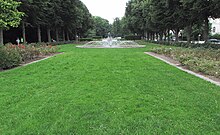Wallstrasse (Rostock)
The Wall Street is a street in the stone gate suburb in the district center of the Hanseatic city of Rostock . It runs parallel to the former southern city wall between the Schwaan Gate, which no longer exists, and the stone gate .
Story, rose garden
After 1830, the fortifications south of the city wall were redesigned into park-like green spaces. The upper and lower walls, bastions and the moat were built. Around 1868 the moat between Schwaanscher Strasse and Steintor was filled in and the Rostock Beautification Association laid out the rose garden. In 1901 a monument to Grand Duke Friedrich Franz III was erected at the western end of the garden . built. It consisted of a bronze statue by Wilhelm Wandschneider with pillars and cross beams and long stone benches. At the end of the Second World War , the monument was removed and a memorial for the victims of fascism (granite cube with sacrificial bowl) was erected instead . In the rose garden there is a monument to the Africa explorer Paul Pogge by Jo Jastram .
Before the air raids in World War II, there was a grammar school in Wallstrasse, the main post office with telegraph office, the Friedrich-Franz boys 'school, which was inaugurated in 1844 and later boys' middle school, and the state house. Only the grammar school (today the large city school) and the state house remained.
Post and Telegraph Office
The post office was located between Rungestrasse (formerly Blücherstrasse) and Buchbinderstrasse (before 1913 Königsstrasse). From 1879 to 1881 the “Kaiserliche Post”, later the main post office, was built in neo-Gothic style with many decorative elements and gables according to plans by the Berlin architects Walter Kyllmann and Adolf Heyden . From 1904 to 1906 the "Imperial Telegraph Office" was added on the east side. The main gable of the building faced the rose garden. The building was partially destroyed by bombs in April 1942 (main wing). After the Second World War, the Rostock telecommunications office was built on the foundation walls in the sober style of the sixties. The preserved east wing on Buchbinderstrasse was included in the construction, the facade was simplified and plastered.
Ständehaus
The Rostock Ständehaus is right next to the stone gate . It was built from 1889 to 1893 according to plans by the Schwerin court building councilor Gotthilf Ludwig Möckel in the style of historicism and served as the parliament building of the Mecklenburg estates. Their representation met here until 1918. These are composed of representatives of the so-called knighthood (landed gentry) and landscape (cities). The imposing building with numerous decorations and turrets was built from brick . Inside there is an atrium with a large flight of stairs, which is surrounded by galleries. The ballroom is paneled and has a barrel vault . According to the use at that time, various sculptures of the mecklenburg princes and representations of mecklenburg coats of arms are attached. After the November Revolution of 1918, the estates were dissolved and the building served various public purposes. During the GDR era, the Volksmarine clubhouse was located here . Today it is the seat of the Higher Regional Court of Mecklenburg-Western Pomerania .
Large Rostock City School
The building of the former large city school Rostock in Wallstraße was built from 1864–1867 according to plans by Rostock city architect Klitzing in a classicist style based on Florentine Renaissance architecture. The three floors are separated by cornices. On the middle gable there are two griffins holding the Rostock coat of arms. The bright colors and clear style are intended to symbolize the modern principles of education. In 2005, the large city school in the inner-city grammar school on Goetheplatz was opened after merging with the Goethe grammar school .
The Great City School had a much longer history than the current building. As early as 1534, the city opened a Latin school in the former Dominican monastery of St. Johannis . Johannes Oldendorp tried to install a standardized school system in Rostock. After Oldendorp left the school, the school was closed again. In 1580 a permanent re-establishment was achieved under David Chyträus . In 1831 the monastery church of St. John's monastery was demolished.
literature
- Ernst Münch , Ralf Mulsow: The old Rostock and its streets. Redieck & Schade, Rostock 2006, ISBN 3-934116-57-4 .
- Heinrich Trost (ed.); Gerd Baier and a (edit.): The architectural and art monuments in the Mecklenburg coastal region. Henschel, Berlin 1990, ISBN 3-362-00523-3 , p. 346ff.
Web links
Coordinates: 54 ° 5 ′ 11 ″ N , 12 ° 8 ′ 17 ″ E



